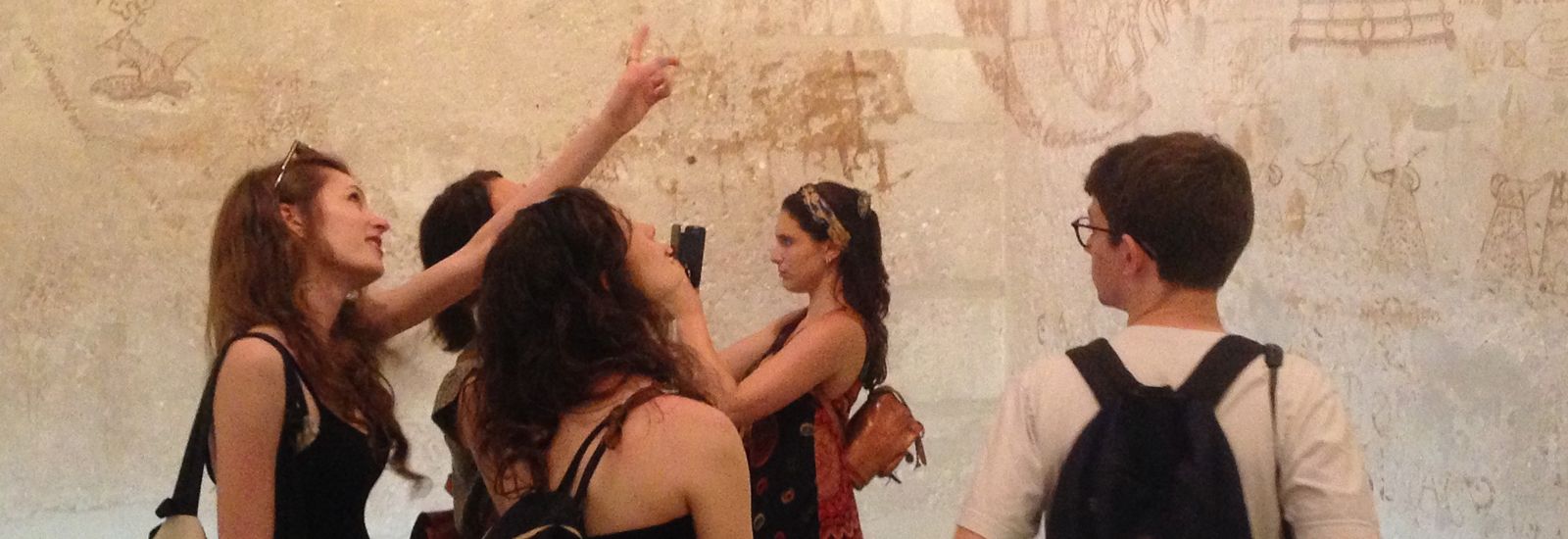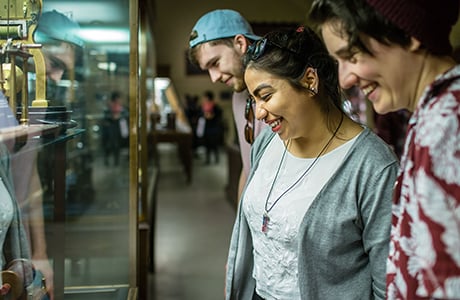What Classes Can You Get a Degree for Art History
Students on a field trip. (Credit: History of Fine art Department) 
History of Art
- Overview
- Construction
- Admissions Requirements
- Careers
- Fees and Funding
- Studying at Oxford
A field of study involving essay writing History of Art, Fine Art, History, English language, a linguistic communication Interviewed: 38% +44 (0) 1865 286830 Unistats data for this form tin can exist found at the lesser of the page
![]()
UCAS code V350 ![]()
Duration iii years (BA) ![]()
Archway requirements AAA ![]()
Subject requirements ![]()
Admissions test(s) None ![]()
Written work One piece, one response ![]()
Admissions statistics*
Successful: xi%
Intake: 15
*3-year average 2019-21 ![]()
Contact
Electronic mail History of Fine art
Anything designed by human being beings exhibits visual qualities that are specific to the place and menstruation in which it originates. History of Art aims to arrive at a historical understanding of the origins, meaning and purpose of fine art and artefacts from a wide range of world cultures, asking about the circumstances of their making, their makers, the media used, the functions of the images and objects, their critical reception and – non least – their subsequent history. As well as educating students in the historical estimation of art in its cultural contexts, a caste in History of Art provides skills in the critical analysis of objects through the cultivation of visual literacy. The acquired skills have broad applicability in a wide range of professional settings, as well as serving the needs of enduring personal enlightenment.
The University collections, including the famous Ashmolean and Pitt Rivers museums, provide subjects for offset-mitt study under the supervision of those entrusted with their care. The celebrated architecture of the urban center and its environment supplies a rich source of study in its own right. The Oxford degree is designed to provide innovative insights into a wide range of world art, drawing its expertise from various Academy faculties and the staff of University collections, likewise as from the department itself. There is a strong emphasis upon how the primary visual and written sources from diverse periods and places can be analysed in different ways. Students are encouraged to ask about the nature of reactions to what we phone call 'art'.
 |  | |
| "My simply knowledge of the subject earlier studying it at Oxford had come from my experience as a Art student at A-level, my ain reading, and from visiting exhibitions and galleries. I was thrilled to exist able to continue my curiosities and farther my cognition in aspects of the course similar the extended essay. To be able to practice a serious, in-depth, and ultimately fascinating report of Walter Sickert and a collection of his drawings at the Ashmolean with some of the world's experts on the subject was something I had wanted to do ever since I found out near the creative person. Not only was I able to embark upon the project academically, merely I also went on an 'art-pilgrimage' across northern France in search of the casino in which the works were made." ARTHUR | '"I chose History of Art at Oxford because the course is unlike those taught at other institutions in that it provides non only a comprehensive agreement of the discipline, simply is very self-cogitating and questions the assumptions we concord when approaching 'artworks' and what we include in that term. I feel that not merely my knowledge has expanded, simply I take been equipped with the skills and frameworks to interpret and sympathise artwork, non only every bit pieces within the canon, but rather every bit all visual culture that operates on so many dimensions, and in and out of many different contexts." SHAUN |
A typical week
Each week you volition have around two lectures, and a weekly tutorial. Teaching usually takes place in the department or in a college, likewise equally in one of the Oxford museums and galleries where tutors often lecture in front of actual works of art. Visits to exhibitions or historical buildings will besides be role of the course. Outside the classroom well-nigh of your time will be spent preparing essays for your tutorials and working in libraries, athenaeum or museums on longer research papers.
Tutorials unremarkably comprise up to three students and a tutor. Grade sizes may vary depending on the options you choose, but there would usually be no more than than around sixteen students, and often significantly fewer. Most tutorials, classes, and lectures are delivered by staff who are tutors in their subject. Many are world-leading experts with years of experience in teaching and research. Some teaching may too exist delivered by postgraduate students who are studying at doctorate level.
To notice out more about how our pedagogy year is structured, visit our Academic Year folio.
Course structure
| Year 1 | |
| COURSES Four elements are taken:
Students also have the opportunity to undertake a French, German or Italian for Art Historians course through the University's Language Centre. No previous experience or qualifications are required for these courses and they do not form part of the cess. | ASSESSMENT First University examinations: three written papers and one extended essay |
| YEARS 2 AND 3 | |
| COURSES 7 elements are taken:
| Assessment Final University examinations: four or v written papers, one or two extended essay(due south) and one thesis |
| For the latest information on all form details and a full list of electric current options see the History of Art website. | |
Academic requirements
Wherever possible, your grades are considered in the context in which they have been achieved. (Come across further information on how we use contextual data.)
Subject requirements
| Essential: | Candidates are required to take taken an essay-based subject area to A-level, Advanced Higher, Higher Level in the IB or any other equivalent. For farther information about what are considered to be essay-based subjects, please read the advice on the History of Art website. |
| Helpful: | History of Art, Fine Art, History, English or a foreign linguistic communication can be helpful to students in completing this course, although they are not required for admission. |
Applying
All candidates must follow the awarding procedure as shown in applying to Oxford. The information below gives specific details for students applying for this class.
Written examination
You do not demand to take a written exam every bit part of an application for this form.
Written work
| Description: | 2 pieces of written work: one marked essay of up to 2,000 words written for an A-level or equivalent course, which volition demonstrate ability to construct a sustained written argument; i personal response, written in no more than 750 words, to a piece of art, architecture or pattern.* |
| Deadline: | 10 November 2022 |
*Applicants should have first-paw access to their chosen object then that they may examine it closely in person. When submitting their response essay, they should include a photo of their called object if possible. In writing their response applicants may focus, equally they wish, on whichever aspects of the object they consider to be virtually significant. These might include the medium, the blueprint or style, the technique, the field of study matter, and/or the location. No special preparation or research is required. The 750-word response should demonstrate curiosity, sensitivity and clarity in response to the called object and visual civilization more generally. It should exist a new piece of writing, not previously submitted for another programme.
Note: Although access to museums and galleries may currently be restricted due to the COVID-nineteen pandemic, candidates should behave in listen that suitable objects may all the same exist accessible. Candidates may wish to write most a local building or public sculpture or a work of art in those spaces to which they still have access. However, if a candidate feels that it is impossible to access a suitable object showtime-hand, they may write most an object that they are able to view in proficient quality reproduction.
For more information, and to download a cover sheet, please see our farther guidance on the submission of written piece of work.
What are tutors looking for?
Candidates should bear witness bear witness of lively engagement with visual culture, both contemporary and historical. Prior knowledge of art history is absolutely not a requirement: many successful applicants have never studied the subject earlier university. What is looked for in applicants is a keen and critical ascertainment of art and of the material environment in general. At interview, candidates are invited to demonstrate willingness to engage in focused word and contend about visual issues, and in improver to respond to i or more photographs of unfamiliar images, which applicants will non be expected to recognise.
For more detail on the choice criteria for this course, please encounter the History of Art website.
Careers
The cultural industries are one of the biggest employers in the world. In addition to museums and galleries, there are many governmental and nongovernmental agencies that work to conserve, research and promote cultural heritage and to further the product of art. Furthermore, History of Art graduates will be especially competitive for posts in any area that requires combinations of visual and exact skills, such as publishing, advertizing, marketing and web-based media, equally well as entering the broad range of professions bachelor to all humanities graduates.
Fees
Boosted Fees and Charges Data for History of Fine art
There are no compulsory costs for this course beyond the fees shown above and your living costs.
Source: https://www.ox.ac.uk/admissions/undergraduate/courses/course-listing/history-art
0 Response to "What Classes Can You Get a Degree for Art History"
Post a Comment